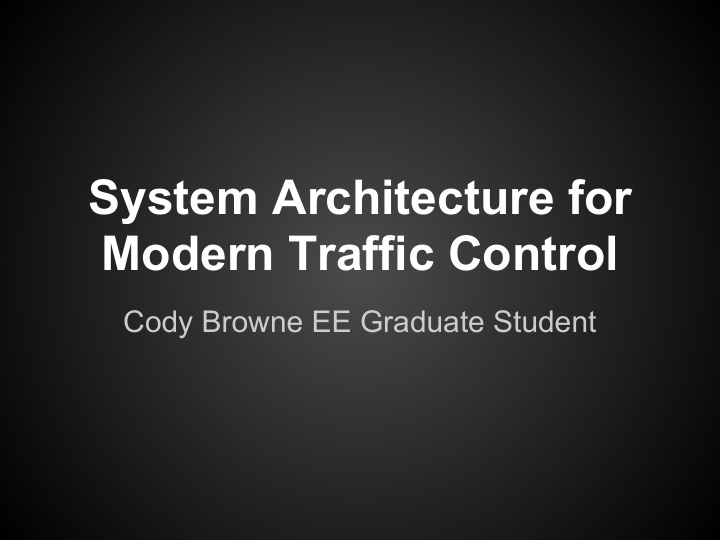



System Architecture for Modern Traffic Control Cody Browne EE Graduate Student
Outline ● Key deficiencies with existing methods ● Key concepts ● Previous and current Smart Signals research ● Implementation ● Going forward
Issues with the Current System ● Static information format. ● More information means more signs.
Issues with the Current System ● Hard wired interface
Issues with the Current System ● Signals unable to keep up with control. Trying to use old signals for new concepts.
Issues with the Current System ● Lack of consideration for mixed mode use has created dangerous situations. ○ Left turns into pedestrians ○ Right turns into pedestrians ○ Bike lanes TriMet is no stranger to left-turn bus accidents such as the one that killed two pedestrians and injured three others in a downtown Portland crosswalk on the night of April 24 [2010] Joseph Rose - Oregon Live
Issues with the Current System ● Driver must look places other than directly ahead for important information such as speed limits, street names, etc. ● There can be too much information in one spot to be consumed.
Issues with the Current System ● Inaccurate countdown on pedestrian signals due to lack of intelligent communication. ● Lack of vehicle or pedestrian countdowns and countups.
Issues with the Current System ● Level of service is different for different users. ○ Pedestrians have to push a button, vehicles don't. ○ Are bicyclists cars or pedestrians?
Key Concepts ● Everyone is involved in traffic.
Key Concepts ● Flexible system is a must. ● Not every intersection is the same.
Key Concepts ● Signals aren't just for drivers.
Smart Signals 2006 - present ● 6 master degree theses ○ 2006-2010 ○ Topics in distributed control and networking. ● Several conference and journal publications ○ Transportation Research Board ○ IEEE Industrial Electronics Society ○ IEEE Intelligent Transportations Systems. ● A lot of undergrads
Smart Signals AAPS ● Advanced Accessible Pedestrian System ● Designed at U of I from start to finish. ● Being manufactured and installed across the US.
Smart Signals IIS ● Intersection ● Providing more Information System information to all users.
Implementation ● Implemented in the AAPS and IIS ● Provides a foundation for many more ideas
Implementation ● Network based system for flexibility. ● New information can use the existing infrastructure. ● Don't need new wires for new signs
Implementation ● Information format is not static ● AAPS - Audio messages can be changed ● IIS - Images can be changed
Implementation ● Information is spread throughout the intersection ● Vehicles can be told there is a pedestrian
Implementation ● Network can be expanded to give information to other entities. ○ Driverless cars ○ Trains/Mass transit ● Network makes more information available at the intersection ○ Environmental conditions ○ Emergency situations
Going Forward ● Speech recognition for pedestrians ○ and other passive detection methods ● Local display for pedestrians ● Smart phone interaction ● Pedestrian tracking
Discussion
Recommend
More recommend